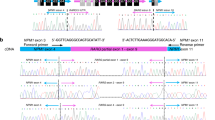Abstract
Acute promyelocytic leukemia (APL) is characterized by a reciprocal chromosomal translocation involving the gene for retinoic acid receptor α (RAR). Most APL patients have a t(15;17) translocation that generates the PML-RAR fusion gene, and such patients respond well to treatment with all-trans retinoic acid (ATRA). Some APL cases also involve rearrangements that fuse RAR to partner genes other than PML, including nucleophosmin (NPM), promyelocytic leukemia zinc finger (PLZF), nuclear mitotic apparatus (NUMA), and Stat5b, but the clinical characteristics of APL without PML-RAR have not been fully clarified. We describe a 64-year-old man with NPM-RAR—positive APL who was receiving hemodialysis therapy for chronic uremia. Complete remission was achieved with ATRA monotherapy and was maintained for 18 months with consolidation chemotherapy. These findings suggest that ATRA can be used to treat APL patients with NPM/RAR as well as APL with PML/RAR.
Similar content being viewed by others
References
Redner RL, Rush EA, Faas S, Rudert WA, Corey SJ. The t(5;17) variant of acute promyelocytic leukemia expresses a nucleophosn-retinoic acid receptor fusion. Blood. 1996;87:882–886.
Chen Z, Brand NJ, Chen A, et al. Fusion between a novel Krüppellike zinc finger gene and the retinoic acid receptor-alpha locus due to a variant t(11;17) translocation associated with acute promyelocytic leukemia. EMBO J. 1993;12:1161–1167.
Wells RA, Catzavelos C, Kamel-Reid S. Fusion of retinoic acid receptor α to NuMA, the nuclear mitotic apparatus protein, by a variant translocation in acute promyelocytic leukaemia. Nat Genet. 1997;17:109–113.
Arnould C, Philippe C, Bourdon V, Gregoire MJ, Berger R, Jonveaux P. The signal transducer and activator of transcription STAT5b gene is a new partner of retinoic acid receptor α in acute promyelocytic-like leukaemia. Hum Mol Genet. 1999;8:1741–1749.
Zelent A, Guidez F, Melnick A, Waxman S, Licht JD. Translocations of the RARα gene in acute promyelocytic leukemia. Oncogene. 2001;20:7186–7203.
Grimwade D, Lo Coco FL. Acute promyelocytic leukemia: a model for the role of molecular diagnosis and residual disease monitoring in directing treatment approach in acute myeloid leukemia. Leukemia. 2002;16:1959–1973.
Grimwade D, Biondi A, Mozziconacci MJ, et al, on behalf of the Groupe Français de Cytogénétique Hématologique, Groupe de Français d’Hematologie Cellulaire, UK Cancer Cytogenetics Group and BIOMED 1 European Community-Concerted Action “Molecular Cytogenetic Diagnosis in Haematological Malignancies.” Characterization of acute promyelocytic leukemia cases lacking the classic t(15;17): results of the European Working Party. Blood. 2000;96:1297–1308.
Licht JD, Chomienne LC, Goy A, et al. Clinical and molecular characterization of a rare syndrome of acute promyelocytic leukemia associated with translocation (11;17). Blood. 1995;85:1083–1094.
Redner RL, Corey SJ, Rush EA, et al. Differentiation of t(5;17) variant acute promyelocytic leukemia blasts by all-trans retinoic acid. Leukemia. 1997;11:1014–1016.
Takitani K, Nagai K, Tamai H, et al. Pharmacokinetics of all-trans retinoic acid in acute promyelocytic leukemia patients on dialysis. Am J Hematol. 2003;74:147–148.
Hummel JL, Wells RA, Dubé ID, Licht JD, Kamel-Reid S. Deregulation of NPM and PLZF in a variant t(5;17) case of acute promyelocytic leukemia. Oncogene. 1999;18:633–641.
Xu L, Zhao WL, Xiong SM. Molecular cytogenetic characterization and clinical relevance of additional, complex and/or variant chromosome abnormalities in acute promyelocytic leukemia. Leukemia. 2001;15:1359–1368.
Betz JL, Behairy AS, Rabionet P, et al. Acquired inv(9): what is its significance? Cancer Genet Cytogenet. 2005;160:76–78.
Yamada K. Population studies of INV(9) chromosomes in 4, 300 Japanese: incidence, sex difference and clinical significance. Jpn J Hum Genet. 1992;37:293–301.
Redner RL, Chen JD, Rush EA, Li H, Pollock SL. The t(5;17) acute promyelocytic leukemia fusion protein NPM-RAR interacts with co-repressor and co-activator proteins and exhibits both positive and negative transcriptional properties. Blood. 2000;95:2683–2690.
Author information
Authors and Affiliations
Corresponding author
About this article
Cite this article
Okazuka, K., Masuko, M., Seki, Y. et al. Successful All-trans Retinoic Acid Treatment of Acute Promyelocytic Leukemia in a Patient with NPM/RAR Fusion. Int J Hematol 86, 246–249 (2007). https://doi.org/10.1532/IJH97.07036
Received:
Revised:
Accepted:
Published:
Issue Date:
DOI: https://doi.org/10.1532/IJH97.07036




